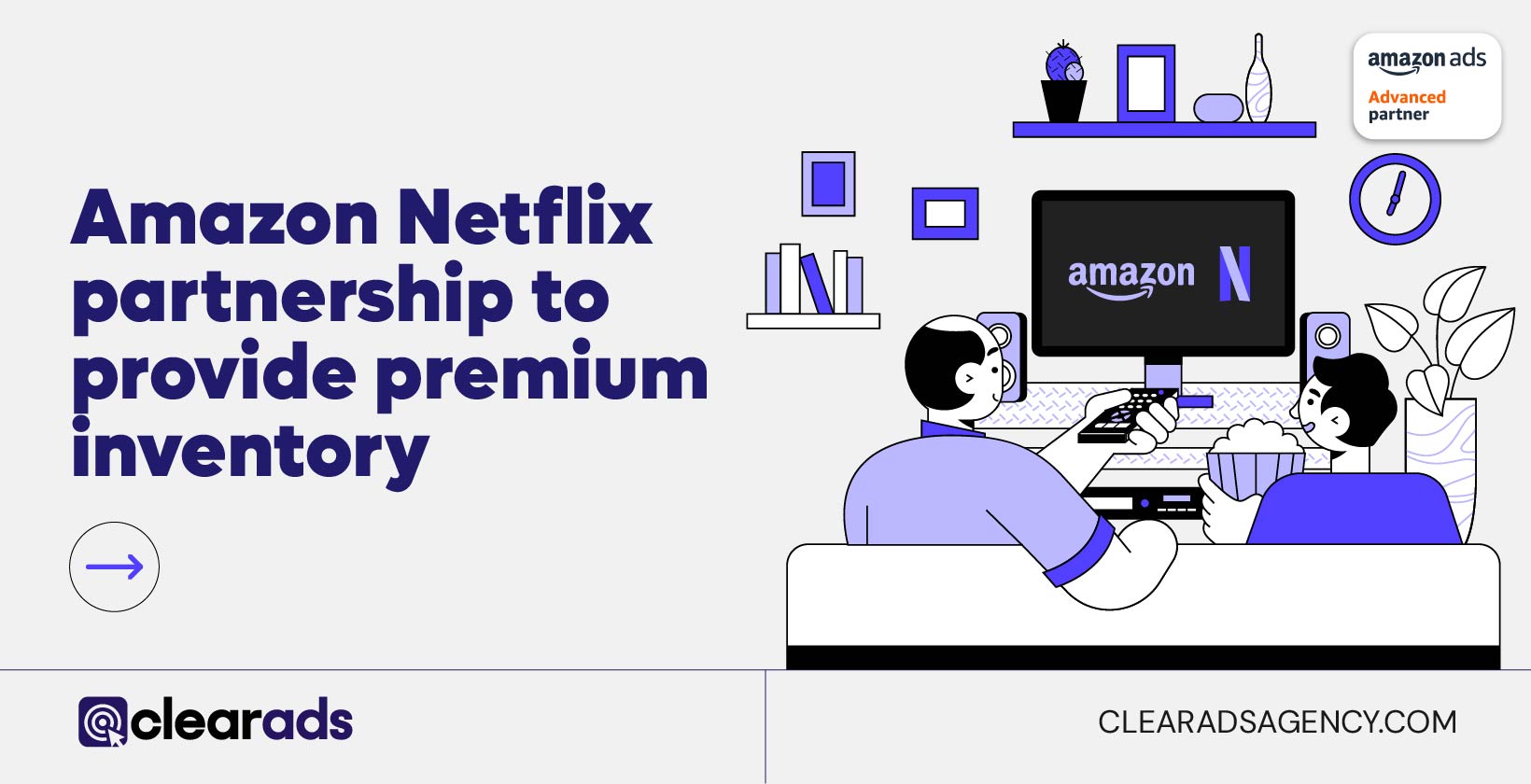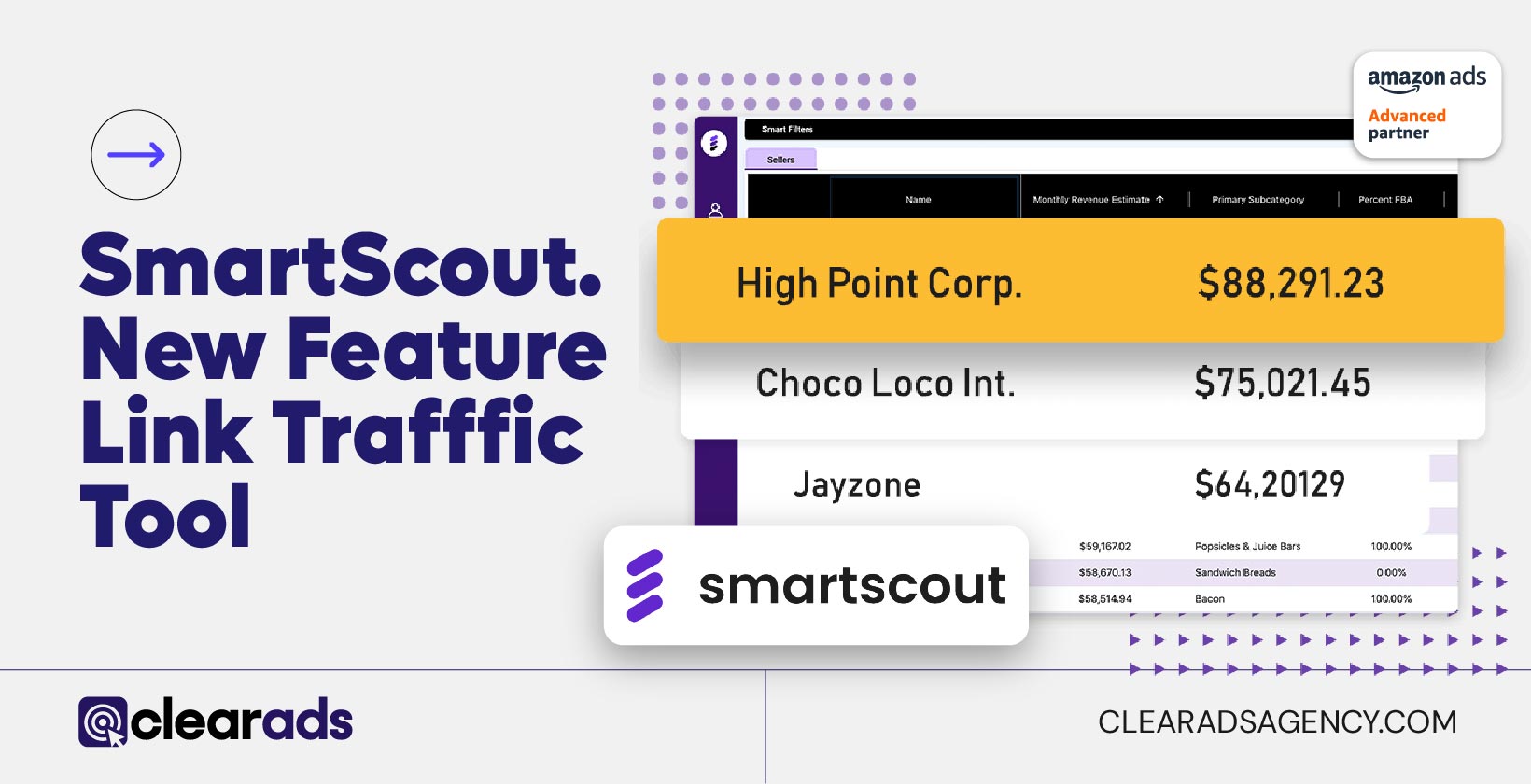This article starts with Marketing Attribution in Amazon Advertising, explaining how advertisers measure ad effectiveness. It covers Multi-Touch Attribution (MTA) and how Amazon’s new model distributes credit across multiple touchpoints. The article then explores what’s new in Amazon’s MTA, including expanded conversion windows, improved conversion path reporting, and long-term sales impact analysis. It explains the differences between last-touch and multi-touch attribution models, highlighting MTA’s advantages in tracking customer journeys. The article also details why MTA matters for advertisers, focusing on ROI measurement, budget optimization, and strategic growth. Finally, it concludes with how advertisers can prepare for MTA in 2025, including steps like tracking multi-touch performance, adjusting campaign strategies, and leveraging Amazon Marketing Cloud (AMC) for deeper insights.
Amazon is fully transitioning to Multi-Touch Attribution (MTA) in 2025, replacing the traditional last-touch attribution model. MTA provides a full-funnel view of how different ad interactions contribute to conversions, giving advertisers more accurate performance insights. Key upgrades include longer conversion tracking windows, detailed conversion path reporting, and predictive sales impact analysis. Unlike last-touch attribution, which gives full credit to a single ad, MTA distributes credit based on real customer engagement patterns. This change enables better budget allocation, improved campaign strategies, and smarter decision-making for brands. To prepare, advertisers should start analyzing MTA data now, refine their ad strategies, test creative assets, and use Amazon Marketing Cloud (AMC) for deeper insights into multi-touch performance.
Amazon’s Multi-Touch Attribution (MTA), launching in 2025, is a major shift from the last-touch model, offering a more accurate way to measure advertising effectiveness. Unlike last-touch attribution, which assigns full credit to a single interaction, MTA tracks multiple touchpoints to better reflect the full customer journey. The article outlines key updates, including a 30-day conversion window, improved conversion path reporting, and machine-learning-driven insights. These enhancements allow advertisers to track upper-funnel ad impact, optimize budget allocation, and make data-driven marketing decisions. To stay competitive, brands should start monitoring multi-touch data, adjust campaign strategies, experiment with ad creatives, and utilize Amazon Marketing Cloud (AMC) for deeper attribution insights.
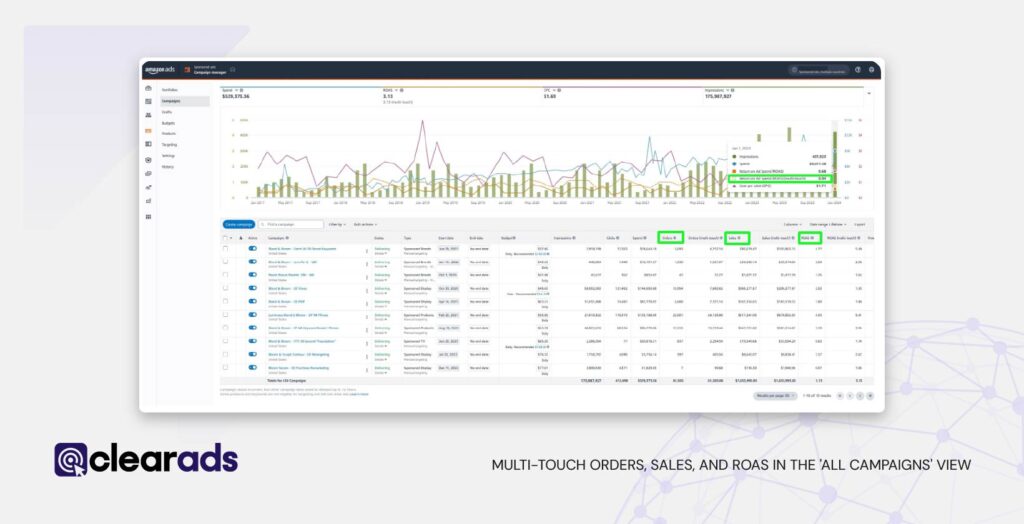
Introduction
In a highly competitive market, accurate performance measurement and strategic ad investments are essential for advertisers looking to maximize their impact. A 2023 Harvard Business Review study revealed that only 5% of 30,000 new product launches succeeded, highlighting the importance of effective marketing strategies from day one. Additionally, research from Boston Consulting Group shows that advertisers must reach customers at least 20 times before a purchase occurs, reinforcing the need for consistent, data-driven engagement across multiple channels.
To help advertisers navigate these challenges, Amazon Ads is introducing Multi-Touch Attribution (MTA) fully in 2025, a more advanced approach to campaign measurement. Unlike last-touch attribution, which credits only the final ad interaction, MTA assigns value to multiple touchpoints, offering a holistic view of the customer journey. By leveraging trillions of shopping signals and advanced machine learning models, Amazon’s new attribution model enables advertisers to better understand their ad effectiveness, optimize budgets, and drive higher conversions.
This article explores Amazon’s approach to marketing attribution, the shift from last-touch to multi-touch attribution, key innovations in MTA, and how advertisers can prepare for this transition.
What is Marketing Attribution in Amazon Advertising?
Marketing attribution is the process of identifying how different advertising touchpoints contribute to conversions, such as purchases, add-to-cart actions, and product detail page views. In Amazon Advertising, attribution models help advertisers measure the effectiveness of their campaigns by determining which ad interactions influenced a customer’s buying decision. By understanding how customers engage with ads across multiple platforms, advertisers can optimize their budget allocation, bidding strategies, and creative execution to improve overall return on ad spend (ROAS).
The Role of Attribution in Amazon Advertising
Amazon’s advertising ecosystem includes various ad formats, such as Sponsored Products, Sponsored Brands, Sponsored Display, and Amazon DSP (Demand-Side Platform). Customers may interact with multiple ads before making a purchase, making it essential to analyze the impact of each touchpoint in the sales funnel. Attribution models provide clarity on which ad types, placements, and targeting strategies contribute the most to conversions.
Historically, Amazon has used last-touch attribution, meaning the final ad interaction before a sale received 100% of the credit. However, this approach overlooks the role of upper-funnel advertising (e.g., Streaming TV, Display Ads, Sponsored Brands) in influencing purchase decisions. To address this limitation, Amazon is introducing Multi-Touch Attribution (MTA) in 2025, which assigns credit to multiple ad interactions based on their actual contribution to the conversion journey.
Types of Marketing Attribution Models
Amazon and other digital advertising platforms use different attribution models to distribute credit for conversions across marketing touchpoints. These models include:
1. Single-Touch Attribution Models
These models assign 100% conversion credit to a single interaction, either the first or last ad the customer engaged with. While easy to implement, they often overlook the influence of multiple touchpoints in a consumer’s journey.
- First-Touch Attribution: Assigns 100% credit to the first interaction a customer has with an ad. Useful for tracking brand awareness efforts, but ignores subsequent ads that nurture the customer toward conversion.
For example, in social media marketing, this attribution model assigns full credit to a consumer’s first interaction with a brand, like seeing an Instagram post for the first time. While this method is simple to apply, it fails to capture the impact of later touchpoints that may play a key role in driving the final purchase.
- When to use:
- Use when you need to identify the most effective channels for generating brand awareness and driving traffic to your site.
- Best for evaluating ad or marketing copy performance and tracking short buying cycles where the first interaction heavily influences conversions.
- Last-Touch Attribution: Gives full credit to the last ad clicked or viewed before a conversion. This has been Amazon’s standard model but fails to account for prior interactions that helped move the shopper down the funnel. Amazon Attribution uses a 14-day last-touch attribution model, meaning a conversion must occur within 14 days of an ad click for that click to receive credit. In the last-touch approach, the most recent ad interaction gets full credit for the conversion.
For example, if a customer clicks a video ad on May 1, a display ad on May 12, and a search ad on May 13, and then makes a purchase on May 17, the video ad click on May 1 wouldn’t receive credit because it falls outside the 14-day attribution window. Since the last-touch model assigns credit to the most recent interaction, the search ad click on May 13 gets full credit for the purchase on May 17.
- When to use:
- Use when you want to determine which channels are most effective at driving conversions and closing sales.
- Best for end-of-funnel shopper activities, where the final touchpoint plays a critical role in influencing purchase decisions.
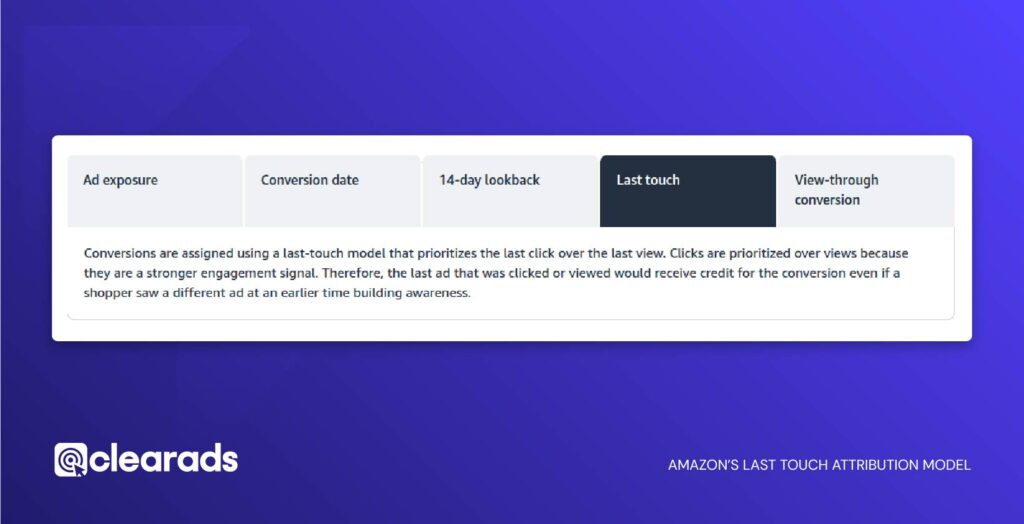
2. Multi-Touch Attribution Models
Multi-touch attribution (MTA) distributes conversion credit across multiple ad touchpoints, providing a more comprehensive view of campaign effectiveness.
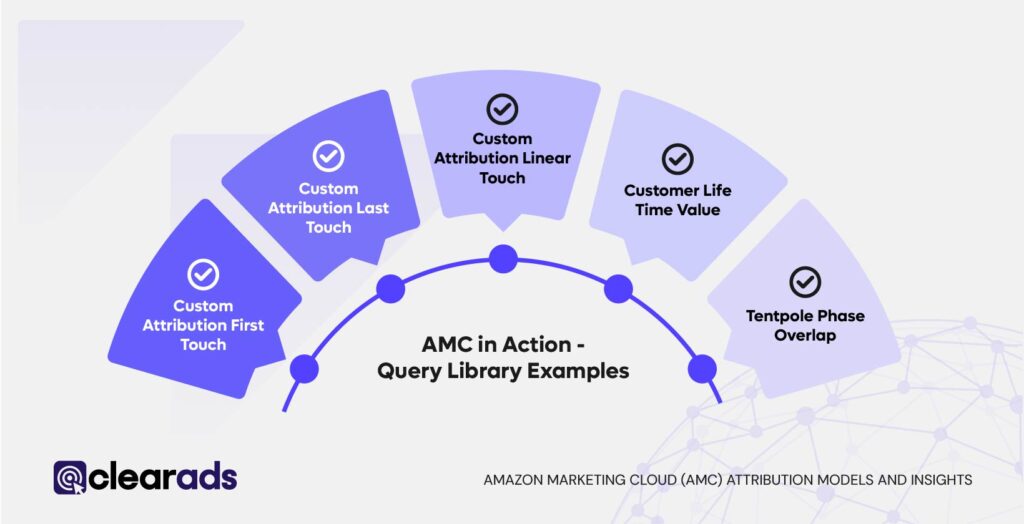
- Linear Attribution: Equally distributes credit among all touchpoints in the customer journey. This model acknowledges every ad interaction but does not differentiate between more or less impactful touchpoints.
For instance, in a campaign running across four different advertising channels, each channel would be assigned 25% of the total conversion credit, regardless of its individual influence. While this model offers a broader view of the customer’s path to purchase, it fails to reflect the varying impact each channel may have on the buying decision and can be more complex to implement.
- When to use:
- Use when you need directional insights on your entire marketing strategy.
- Best for campaigns where each channel has equal importance in relation to your marketing goals.
- Time-Decay Attribution: Gives more credit to recent interactions, assuming that ads closer to the purchase event played a larger role. This is useful for campaigns with longer sales cycles, where customers require multiple engagements before deciding.
- When to use:
- Use when you want to analyze the impact of recent touchpoints compared to earlier ones.
- Best for longer sales cycles, where later interactions play a stronger role in final conversions.
- When to use:
- Position-Based (U-Shaped) Attribution: 40% credit to the first and last touchpoints, with the remaining 20% split among other interactions. This balances brand awareness (first-touch) and conversion influence (last-touch). For example, the first and last interactions often receive a higher share of credit compared to touchpoints in the middle. This model is useful for identifying the most influential stages in the path to purchase.
- When to use:
- Use when you want a balanced measure of marketing channel impact while emphasizing both the first and last touchpoints.
- Best for less complex customer journeys, where both brand awareness and final conversion interactions are equally important.
- When to use:
- Custom Attribution: Allows advertisers to assign credit based on their marketing strategy and performance data. This model is the most tailored but requires deep data insights and manual configuration.
- When to use:
- Use when you need highly personalized insights and want to control how credit is assigned to different touchpoints.
- Best for businesses with sufficient historical data and machine learning expertise, allowing custom weight distribution based on specific goals.
- When to use:
Why Does Marketing Attribution Matters?
- Better Budget Allocation: Advertisers can invest in high-performing ad types and optimize underperforming campaigns.
- Improved ROAS Measurement: Attribution data clarifies which touchpoints are driving conversions.
- Optimized Ad Strategy: Identifies which keywords, placements, and ad creatives contribute most to purchases.
- Full-Funnel Visibility: Helps advertisers track customer engagement beyond just the final ad click, allowing for better brand awareness and conversion strategies.
With Amazon’s Multi-Touch Attribution launching in 2025, advertisers will move beyond last-touch attribution’s limitations, gaining greater visibility into how different ad interactions shape the path to purchase.
What is Multi-Touch Attribution (MTA)?
Multi-Touch Attribution (MTA) is an advanced attribution model that distributes credit for conversion across multiple ad interactions instead of assigning all credit to the last ad clicked or viewed. This model helps advertisers understand the combined impact of different ad types throughout the customer journey, offering a clearer picture of how marketing efforts drive sales.
Amazon’s MTA uses machine learning algorithms to analyze trillions of shopping signals and determine how various ad touchpoints contribute to purchase decisions. By considering the relative value of each interaction, MTA provides advertisers with a full-funnel view of campaign performance, improving budget allocation and strategic decision-making.
This new model marks a shift away from last-touch attribution, allowing advertisers to measure the effectiveness of upper-funnel tactics such as Streaming TV, Sponsored Brands, and Display Ads, which often play a crucial role in influencing consumer behavior before a purchase occurs.
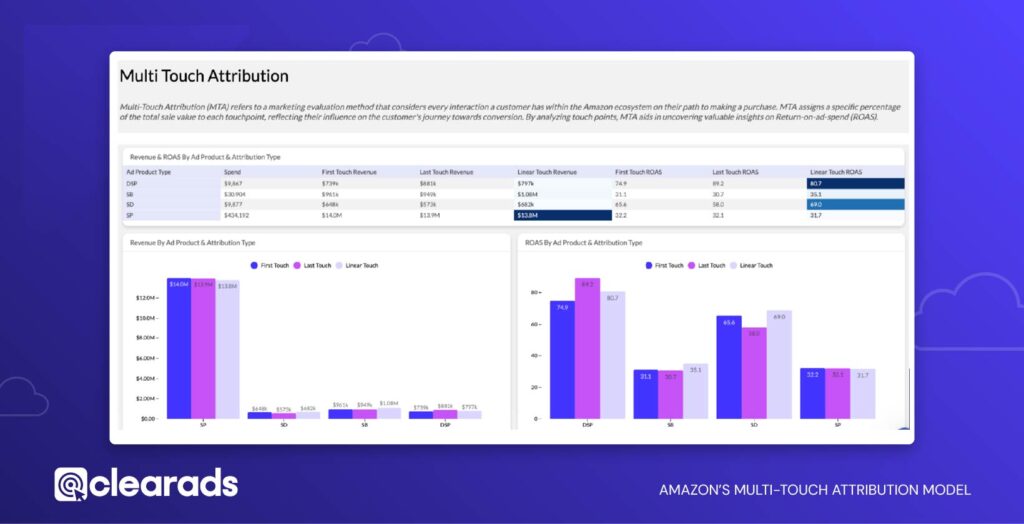
What’s New in Amazon’s Multi-Touch Attribution?
Amazon’s Multi-Touch Attribution (MTA), launching in 2025, introduces a more advanced approach to measuring ad effectiveness by assigning conversion credit across multiple ad interactions. Unlike the traditional last-touch attribution model, MTA provides advertisers with a full-funnel view of how various ad formats, such as Streaming TV, Sponsored Brands, Sponsored Display, and Sponsored Products, contribute to conversions.
The new model leverages machine learning, A/B testing, and extensive shopping data to determine the true impact of ad interactions. Key innovations include expanded conversion tracking, improved conversion path reporting, long-term sales projections, and deeper insights powered by trillions of data points.
1. Trillions of Shopping Signals
Amazon’s MTA processes trillions of shopping, browsing, and streaming signals to determine how various ad interactions influence consumer decisions. These signals help Amazon:
- Identify patterns in customer behavior across different ad formats.
- Measure how brand awareness ads (e.g., Streaming TV, Display Ads) contribute to later conversions.
- Analyze cross-device and cross-channel engagements, ensuring more precise attribution.
By leveraging this massive dataset, Amazon provides advertisers with a clearer understanding of ad effectiveness across multiple platforms, helping them optimize strategies based on real user interactions.
2. Hundreds of Thousands of A/B Tests
Amazon’s MTA uses hundreds of thousands of randomized control trial (RCT) A/B tests to validate its attribution model. These tests help determine:
- Which ads contribute most to conversions across different touchpoints.
- The relative impact of upper-funnel vs. lower-funnel ads in driving sales.
- How ad placement, format, and messaging affect conversion rates.
By conducting large-scale A/B testing, Amazon ensures MTA accurately reflects real consumer behavior, allowing advertisers to:
- Make data-driven budget allocation decisions.
- Adjust bidding strategies based on proven ad impact.
- Refine creative strategies to maximize engagement.
3. Expanded Conversion Windows (30-Day Conversion Path Tracking)
Amazon’s new 30-day conversion tracking window enables advertisers to analyze customer journeys over a longer period, capturing interactions that last-touch attribution might ignore.
Key benefits of the expanded window:
- Advertisers can see how ads drive engagement over time, even if the conversion happens weeks after the first interaction.
- Upper-funnel tactics (e.g., Streaming TV, Sponsored Brands, Amazon DSP Ads) get proper attribution for their role in influencing decisions.
- Helps brands understand seasonal shopping behavior, where customers might engage with ads weeks before purchasing.
With this improvement, advertisers can optimize campaigns based on long-term engagement trends rather than focusing only on immediate conversions.
4. Improved Conversion Path Reporting
Amazon is introducing self-service conversion path reporting in the Ad Console and Amazon DSP, allowing advertisers to view the top-performing ad conversion paths from the previous 30 days.
This feature helps brands:
- Identify which ad combinations drive the most sales.
- See how customers interact with different ad types before converting.
- Compare conversion paths to optimize budget distribution.
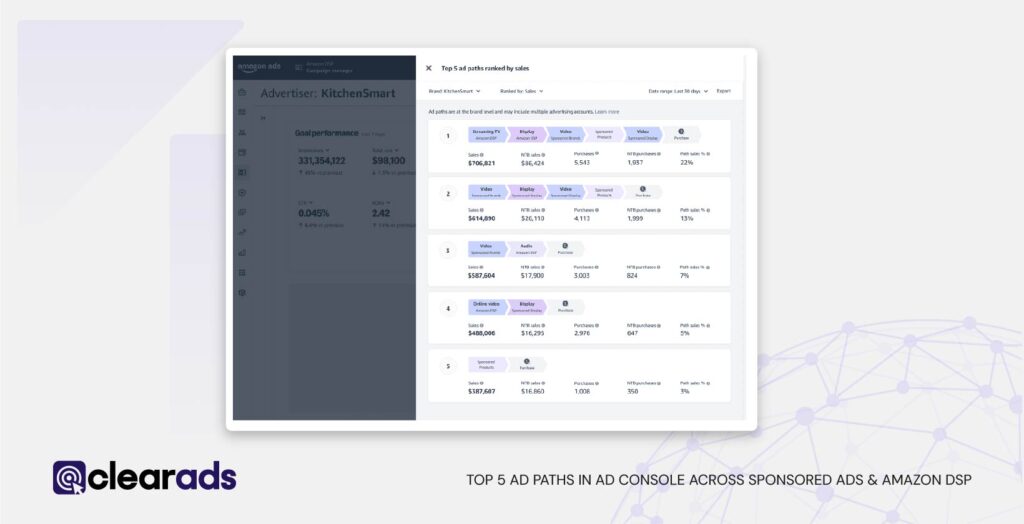
For example, an advertiser may discover that customers who first saw a Streaming TV ad and later engaged with a Sponsored Products ad were more likely to convert than those who only interacted with lower-funnel ads.
By accessing detailed conversion paths, advertisers can make smarter marketing decisions based on actual consumer behavior. These insights will soon be accessible directly from the ad console and Amazon DSP reports, making it easier than ever to refine your strategies.
5. Project Long-Term Sales Impact
Amazon’s MTA introduces long-term sales insights, estimating future revenue potential, based on past customer interactions. With long-term sales insights, you can now understand the ripple effects of upper-funnel tactics on your future revenue. This feature:
- Predicts how effectively campaigns move new-to-brand shoppers down the funnel.
- Attributes credit to awareness-building ads, even if the sale happens months later.
- Helps brands forecast future performance and make strategic budget adjustments.
For example, if a customer clicks on an ad but doesn’t purchase immediately, Amazon’s MTA will analyze historical patterns to determine the likelihood of that customer converting in the future. This ensures that early-stage engagement efforts receive proper recognition, allowing advertisers to balance short-term and long-term marketing strategies.
How are the Last-Touch Attribution and Multi-Touch Attribution Models different?
Amazon’s Multi-Touch Attribution (MTA) represents a major shift from the traditional Last-Touch Attribution model, providing advertisers with a more accurate view of how multiple ad interactions contribute to conversions. While Last-Touch Attribution assigns 100% of the conversion credit to the final ad interaction, MTA distributes credit across multiple touchpoints based on their role in the customer’s journey.
1. Last-Touch Attribution: A Limited View of Conversions
Historically, Amazon Ads relied on Last-Touch Attribution, meaning:
- The last ad clicked or viewed before a purchase was given full credit for the sale.
- Previous ad interactions (such as Streaming TV or Sponsored Brands) were ignored in the attribution model.
- Advertisers could not measure how upper-funnel ad formats contributed to conversions.
Example of Last-Touch Attribution:
- A customer sees a Sponsored Display Ad but doesn’t take immediate action.
- Later, they engage with a Sponsored Brand Video Ad.
- Finally, they click on a Sponsored Products Ad and complete the purchase.
In Last-Touch Attribution, only the Sponsored Products Ad receives credit, even though earlier ads played a role in influencing the decision. This skews performance measurement and may lead advertisers to underinvest in top-of-funnel strategies.
2. Multi-Touch Attribution (MTA): A Full-Funnel Approach
Amazon’s Multi-Touch Attribution model, launching in 2025, uses machine learning to distribute conversion credit across multiple ad interactions, offering a holistic view of the entire customer journey.
- Recognizes all touchpoints leading up to a purchase.
- Assigns proportional credit to different ad interactions based on their role in conversion.
- Uses AI-driven analysis of trillions of shopping signals and A/B test results to determine impact.
Example of Multi-Touch Attribution:
- A customer sees a Streaming TV Ad, introducing them to the brand (awareness).
- They later click on a Sponsored Brands Ad, exploring products (consideration).
- Finally, they click on a Sponsored Products Ad and make a purchase (conversion).
In MTA, each of these three ad touchpoints receives credit, weighted based on its contribution to the conversion.
3. Key Differences Between Last-Touch & Multi-Touch Attribution
| Feature | Last-Touch Attribution | Multi-Touch Attribution (MTA) |
| Credit Assignment | 100% to the final interaction | Credit is distributed across multiple touchpoints |
| Upper-Funnel Impact | Ignored (streaming TV, Display Ads get no credit) |
Recognized (awareness-stage ads receive partial credit) |
| Customer Journey Analysis | Limited view (tracks only last ad before purchase) |
Full-funnel visibility (tracks all contributing ads) |
| Conversion Path Reporting | Not available | New feature showing the top-performing ad conversion paths |
| Budget Optimization | May lead to over-investing in lower-funnel ads | Encourages balanced investment across funnel stages |
| Use of AI & Machine Learning | No AI-driven insights | Uses trillions of data points & A/B tests to refine accuracy |
Why Amazon’s MTA Matters for Advertisers?
Amazon’s Multi-Touch Attribution (MTA) introduces a more sophisticated approach to measuring ad performance, allowing advertisers to accurately assess the impact of multiple ad interactions on conversions. This shift from last-touch attribution to multi-touch modeling enables brands to optimize their advertising spend, refine campaign strategies, and drive long-term business growth.
1. More Accurate ROI Measurement
Amazon’s MTA provides a clearer picture of Return on Investment (ROI) by tracking how different ad types contribute to conversions throughout the entire funnel. Unlike last-touch attribution, which overvalued lower-funnel ads, MTA allows advertisers to:
- See which ad combinations drive the best performance.
- Measure how upper-funnel ads contribute to long-term sales growth.
- Understand incremental revenue impact from various ad interactions.
By accurately distributing credit across touchpoints, advertisers can determine which campaigns generate the highest ROI and adjust bidding strategies accordingly.
2. Optimized Budget Allocation
MTA helps advertisers allocate their budget more effectively by showing the true impact of each ad format in the conversion process. With a data-driven approach, advertisers can:
- Shift spending to high-performing ad combinations.
- Increase investment in under-valued upper-funnel ads like Streaming TV and Sponsored Brands.
- Balance budget allocation across awareness, consideration, and conversion stages.
For example, if MTA shows that Sponsored Brand Video Ads play a critical role in driving conversions, advertisers may increase spending on video formats rather than relying solely on Sponsored Products.
3. Enhanced Ad Campaign Optimization
MTA enables smarter ad optimizations by identifying which ad sequences work best. Advertisers can:
- Analyze top-converting ad paths using Amazon’s new Conversion Path Reporting.
- Test different ad formats to see how they interact within the customer journey.
- Refine targeting strategies to reach high-value audiences at different funnel stages.
For example, A/B tests may reveal that a combination of DSP display ads and Sponsored Products ads leads to higher conversion rates than using Sponsored Products alone. Advertisers can then adjust their ad strategy to maximize performance.
4. Clear View of Streaming TV Impact
Previously, Streaming TV and upper-funnel ads were underrepresented in Amazon’s attribution models. With MTA, advertisers now:
- Track the role of Streaming TV ads in generating awareness and influencing future purchases.
- Measure how upper-funnel engagement leads to lower-funnel conversions.
- Understand the impact of brand-building campaigns on long-term sales.
For example, MTA might show that customers who watch a Streaming TV ad first are more likely to click on a Sponsored Product ad later, proving that upper-funnel ads drive demand.
5. Strategic Growth
MTA gives advertisers long-term insights into sales performance, helping them build sustainable growth strategies by:
- Tracking new-to-brand shoppers and their purchasing behaviors.
- Predicting long-term revenue trends based on past ad interactions.
- Scaling campaigns efficiently by investing in ads that drive future conversions.
For instance, if data shows that a certain ad type consistently attracts new customers, brands can increase spending in that area to expand their market share.
6. Better Decision-Making
Amazon’s MTA enables data-driven decision-making by providing accurate, AI-powered insights into campaign effectiveness. Advertisers can:
- Identify which ad types work best for different audiences.
- Adjust messaging and creative elements based on conversion data.
- Optimize marketing mix strategies across different sales channels.
With multi-touch attribution providing a full-funnel view, advertisers can make smarter, informed choices about where to invest their ad spend for maximum efficiency.
How to Prepare for Amazon’s Multi-Touch Attribution in 2025?
Amazon’s Multi-Touch Attribution (MTA), launching in 2025, marks a fundamental shift in how conversions are measured in Amazon Advertising. Instead of assigning full credit to the last ad interaction, MTA distributes credit across multiple touchpoints based on their contribution to the customer journey.
To fully leverage this data-driven attribution model, advertisers must adjust their campaign strategies, optimize ad creatives, and refine budget allocation. The following steps will help advertisers prepare for MTA’s rollout and maximize its benefits.
1. Start Tracking Multi-Touch Performance Now
Since MTA is already rolling out in some ad consoles, advertisers should begin monitoring multi-touch attribution data alongside last-touch reports to understand how the new model impacts campaign performance.
Key Actions:
Compare MTA vs. Last-Touch Data
- Evaluate how conversion credit is distributed across different ad types.
- Identify previously undervalued touchpoints, such as Streaming TV and Sponsored Brands.
Analyze Conversion Path Reports
- Use Amazon’s Conversion Path Reporting to see which ad sequences generate the highest conversions.
- Identify if upper-funnel ads (Streaming TV, Display Ads) contribute significantly to lower-funnel sales.
Monitor ACoS & ROAS Changes
- Since MTA redistributes conversion credit, advertisers should expect adjustments in Advertising Cost of Sales (ACoS) and Return on Ad Spend (ROAS).
- Example: A campaign previously showing a ROAS of 4.5 under last-touch attribution may appear lower in MTA if credit is now being shared with other ad interactions.
Tracking these insights before the full rollout allows advertisers to adjust their bidding and budget strategies proactively.
2. Adjust Campaign Strategies for Full-Funnel Success
With MTA ensuring proper credit allocation across all ad touchpoints, advertisers need to develop full-funnel strategies that align with customer behavior at every stage of the buying journey.
Key Adjustments:
Invest in Upper-Funnel Ads
- Streaming TV, Sponsored Brands, and Display Ads will now receive attribution credit, making them more valuable in driving conversions.
- Shift part of the budget from purely bottom-funnel ads (Sponsored Products) to branding and awareness-focused formats.
Build Cohesive Ad Sequences
- Structure campaigns so that awareness-stage ads push shoppers toward consideration-stage ads, leading to conversion.
- Example: A Streaming TV ad should be followed by a retargeting campaign via Sponsored Display, eventually leading to a Sponsored Products conversion ad.
Reallocate Budget for Holistic Impact
- Adjust spending to optimize full-funnel impact, rather than focusing only on last-click performance.
- Example: If Sponsored Brands ads play a strong role in driving conversions under MTA, increase investment in brand-building campaigns.
By aligning campaign structures with MTA’s multi-touch approach, advertisers can ensure stronger engagement at every stage of the customer journey.
3. Test & Optimize Ad Creatives
Since MTA tracks multiple ad interactions, optimizing ad creatives for different funnel stages is crucial. Testing different messaging, visuals, and placements helps identify the most effective ad sequences.
Key Optimization Tactics:
A/B Testing Across Multiple Ad Types
- Test different versions of Sponsored Brands, Display Ads, and Streaming TV ads to see which combination leads to the highest engagement and conversion rates.
- Example: A retailer could compare the effectiveness of Sponsored Brand Video Ads vs. Static Sponsored Brands Ads in driving downstream conversions.
Refine Messaging for Funnel Stages
- Upper-funnel ads (Streaming TV, Display Ads): Focus on brand awareness and storytelling.
- Mid-funnel ads (Sponsored Brands, DSP Retargeting): Highlight product benefits and comparisons.
- Lower-funnel ads (Sponsored Products, Search Ads): Feature clear calls-to-action (CTA) to drive purchases.
Experiment with Ad Formats & Placements
- Compare performance across different ad placements, such as Amazon homepage ads vs. product page ads.
- Optimize creatives to match the intent and browsing behavior of different audience segments.
By testing and refining ad creatives, advertisers can maximize their influence at every touchpoint, ensuring stronger conversion rates.
4. Monitor Amazon Ads Announcements & Beta Programs
Amazon is gradually rolling out MTA, with updates expected throughout 2024 and early 2025. Staying informed about Amazon’s latest advertising tools and insights is essential for gaining a competitive advantage.
Key Actions:
Join Amazon Ads Beta Programs
- Advertisers selected for MTA beta testing can access early insights and test new features before competitors.
Track Changes in Ad Console & Amazon DSP Reports
- Monitor new metrics in reporting dashboards, including:
- Multi-Touch ROAS (Return on Ad Spend)
- Multi-Touch ACoS (Advertising Cost of Sales)
- Conversion Path Insights
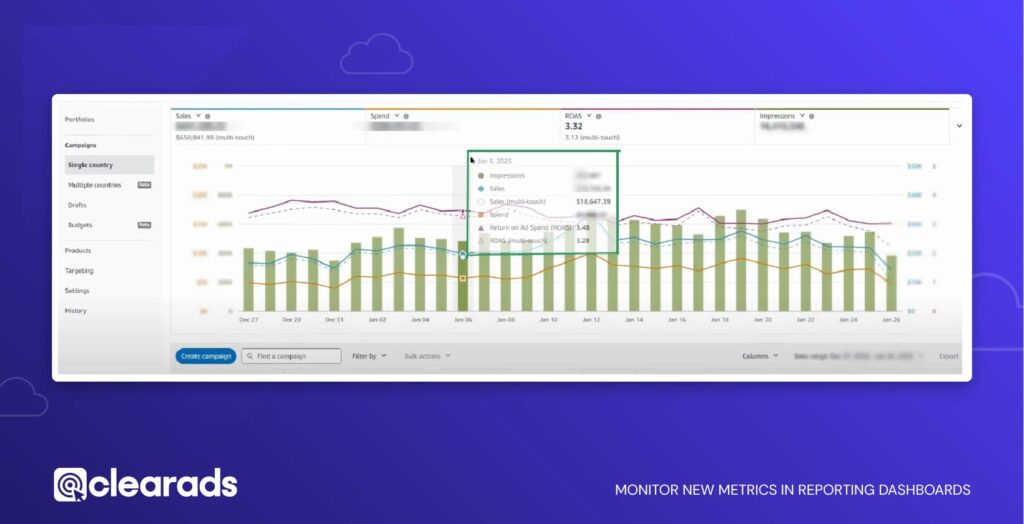
Attend Amazon Ads Webinars & Unboxed Events
- Amazon regularly announces advertising innovations at industry events.
- Advertisers should stay updated on MTA-related updates, best practices, and success stories.
By staying engaged with Amazon Ads developments, advertisers can adopt MTA strategies ahead of competitors and make data-driven adjustments.
5. Leverage Amazon Marketing Cloud (AMC) for Deeper Insights
Amazon Marketing Cloud (AMC) is one of the most powerful tools for tracking full-funnel performance, especially with the introduction of MTA. Since AMC allows advertisers to run custom data queries, it provides deeper insights than standard Amazon Ad reports.
How to Use AMC for MTA Optimization?
Analyze Multi-Touch Conversion Patterns
- AMC enables advertisers to break down how different ad interactions influence conversions.
- Example: A retailer could analyze which ad sequences lead to the highest customer lifetime value (LTV).
Measure the Impact of Upper-Funnel Ads
- AMC allows advertisers to quantify how Streaming TV and Sponsored Brands influence later purchases.
- Example: If customers who watched a Streaming TV ad convert at a higher rate, brands can justify increased investment in video ads.
Refine Audience Targeting & Segmentation
- AMC helps advertisers identify which customer segments engage most with different ad types.
- Advertisers can create custom audience segments based on historical multi-touch engagement patterns.
Using AMC alongside Amazon’s new MTA reporting tools gives advertisers a data-driven advantage in optimizing campaign strategies.

